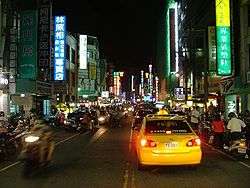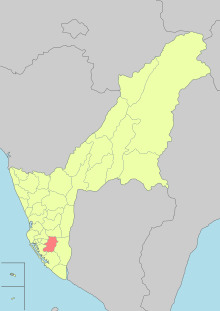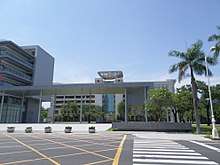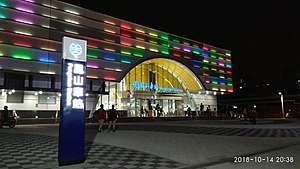Fongshan District
Fongshan District[1][2][3][4][5][6][7] (Chinese: 鳳山區; Hanyu Pinyin: Fèngshān Qū; Tongyong Pinyin: Fòngshan Cyu; Pe̍h-ōe-jī: Hōng-soaⁿ-khu) is a district located in southern Kaohsiung, Taiwan. Fongshan is one of the administrative centers of Kaohsiung and is home to the Chinese Military Academy. There are three military units currently located in Fongshan. Both Chinese Military Academy and R.O.C. Army Infantry School were migrated from mainland China and re-established here in 1950. Chung Cheng Armed Forces Preparatory School was established in 1976. These three units used to be the main economic driving force, but their importance seems to diminish gradually as Fongshan has established itself as a conjunction between Pingtung City and Kaohsiung.
Fongshan 鳳山區 Fengshan | |
|---|---|
| Fongshan District[1] | |
 Downtown Fongshan | |
Fongshan District Office, Kaohsiung City | |
 Location of Fongshan District | |
| Coordinates: 22°38′N 120°21′E | |
| Country | Republic of China (Taiwan) |
| Municipality | Kaohsiung |
| Area | |
| • Total | 26.76 km2 (10.33 sq mi) |
| Population (January 2016) | |
| • Total | 356,507 |
| • Density | 13,000/km2 (35,000/sq mi) |
| Time zone | UTC+8 (National Standard Time) |
| Website | fsdo |


Although there are several industrial zones at the rim or outskirt of the city, the major life style in Fongshan seems to be very residential. Many apartments were built near the Kaohsiung city center as a result of shifting economic weight. Like most of areas in Taiwan, it also has many night markets scattered around within the city. Most of the night markets run until 2:00 am. Some of them run business on different days of a week, but some others are all year round. Some of them are temporary, while others have become permanent establishments.
History
During the Dutch era, the current location of Fongshan was called Pongsoya (see Linbian, Pingtung), a group of eight Makatao villages and one of the most populous areas of Taiwan.
Qing Dynasty
During Qing rule, Fengshan District (Formosa) included areas south of Tainan (then called "Taiwan-fu") and west of the mountains. In 1875, the southern part of Fongshan County was separated into Hengchun District.
Empire of Japan
In 1901, during Japanese rule, Hōzan Chō (Japanese: 鳳山廳) was one of twenty local administrative offices established. According to the 1904 census, Hozan town had a population of 5,750, whereas Hozan District had a population 173,016.[8] In 1909, this unit was merged into Tainan Chō (臺南廳). From 1920 to 1945, under the prefecture system, Hōzan Town (鳳山街) was administered under Hōzan District, Takao Prefecture. After the colonial government started to develop Takao Harbor in the early 20th century, the importance of Fongshan was declining.
Republic of China
Fongshan was the capital of Kaohsiung County, established in 1945 as an urban township. It was upgraded to a county-controlled city on 1 July 1972, and has been a city seat of Kaohsiung City since 25 December 2010 along with Lingya District.
Administrative divisions
The district consists of Xiankou, Chenggong, Guangming, Xingzhong, Nanxing, Hede, Fenggang, Zhonghe, Zhenbei, Xianya, Wenying, Zhenxi, Zhentung, Beiding, Zhongzheng, Zhennan, Laoye, Ruizhu, Zhongyi, Chengyi, Xinxing, Haiguang, Zhongcheng, Xinjia, Wuhan, Zhengyi, Yijia, Fuxing, Tungmen, Ruixing, Tianxing, Xinjiang, Guotai, Fengtung, Xinfu, Guoguang, Guolong, Wende, Guobei, Caogong, Xingren, Wufu, Zhongxiao, Shengming, Hexing, Xiehe, Wenshan, Fucheng, Chengde, Sanmin, Beimen, Fujia, Nancheng, Wenhua, Dade, Wusong, Wenheng, Wenfu, Chengxin, Chengzhi, Guofu, Wuqing, Haiyang, Xinwu, Xinle, Xintai, Zhonglun, Zhongrong, Zhongmin, Erjia, Longcheng, Furong, Shanmei, Nanhe, Fuxiang and Baoan Village.[9]
Climate
Fongshan is in the tropical zone. Average temperature is 23 °C. Average precipitation is 1,500 to 2,000 millimeters.
Government institutions
Education
Tourist attractions
- Shuangci Pavilion (Mazu) Temple
- Caogong Temple
- Cheng Huang Temple
- Chenglan Fort
- Dadong Arts Center
- Dongbian Gate
- Dongfu Bridge
- Fengshan Longshan Temple
- Fengshan Tiangong Temple
- Fengshan Stadium
- Fongshan Community Culture Museum
- Fongyi Tutorial Academy
- Former Japanese Navy Fongshan Communication Center
- Kaohsiung City Symphony Orchestra
- Pingcheng Fort
- Shuangcih Pavilion
- Syunfong Fort
- Weiwuying Metropolitan Park
- Zhonghua Street Night Market
Transportation
Roads
- National Highway No. 1 (Taiwan)
- Provincial Highway No. 1 (Taiwan)
- Provincial Highway No. 1 - Shu (Taiwan)
- Provincial Highway No. 25 (Taiwan)
- Provincial Highway No. 88 (Taiwan)
Rails
- Fongshan West Station, Fongshan Station, Dadong Station and Fongshan Junior High School Station of Kaohsiung Mass Rapid Transit
- Fengshan railway station of Taiwan Railways Administration
Notable natives
- Chang Chun-yen, former electrical engineer and professor
- Chen Chi-chuan, Mayor of Kaohsiung (1960–1968)
- Kang Kang, singer and television host
- Lin Ching-hsuan, former writer
- Sammi Kao, singer
- Tyzen Hsiao, composer, pianist and conductor
See also
- Walled City of Fongshan
Notes
- "Administrative Districts". Kaohsiung Municipal Government. 30 September 2016. Retrieved 4 April 2017.
Fongshan District:
- "Fongshan History". Welcome to Fongshan District Office. Retrieved 24 July 2019.
On December 25, 2010, Kaohsiung City and County were consolidated, and the Office was renamed as Fongshan District Office of Kaohsiung City.
- "Welcome to Fongshan District First Household Registration Office, Kaohsiung City". Fongshan District First Household Registration Office. Retrieved 24 July 2019.
- Fongshan (Variant - V) at GEOnet Names Server, United States National Geospatial-Intelligence Agency
- Chen Yu-fu; Jonathan Chin (19 June 2019). "Commission researches White Terror-era prisons". Taipei Times. Retrieved 24 July 2019.
The euphemistically named “Fongshan Guesthouse” (鳳山招待所) in Kaoshiung’s Fongshan District (鳳山) is one of three intact prison facilities used in the city during the White Terror era, it said.
- M. Chuang (19 June 2019). "Second Wave of Dengue Cluster Infections Begins 高雄新增1登革熱病例 疑群聚疫情第2波". Public Television Service. Retrieved 24 July 2019.
With the outbreak spreading, Fongshan District is on high alert due to its proximity to Sanmin District. The chief of Fongshan's Guoguang Borough says the military was supposed to disinfect the borough but never showed up.
- Chuan-Hung Chiu, Tzai-Hung Wen, Lung-Chang Chien, Hwa-Lung Yu (10 October 2014). "A Probabilistic Spatial Dengue Fever Risk Assessment by a Threshold-Based-Quantile Regression Method". PLoS ONE. Retrieved 24 July 2019.
Fongshan District, located to the southeast of Kaohsiung City and covering an area of 26 km2, was the former capital of Kaohsiung County and has a population of approximately 36 000.
CS1 maint: uses authors parameter (link) - Takekoshi (1907), p. 199-200.
- https://www.cec.gov.tw/pc/en/TV/nm64000001200000000.html
References
- Takekoshi, Yosaburō (1907). Japanese rule in Formosa. London, New York, Bombay and Calcutta: Longmans, Green, and co. OCLC 753129. OL 6986981M.CS1 maint: ref=harv (link)
External links
| Wikimedia Commons has media related to Fongshan District, Kaohsiung. |
| Look up Fongshan in Wiktionary, the free dictionary. |
